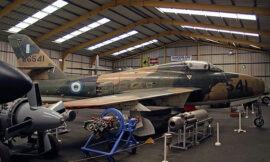The Piper L-4, known as the Grasshopper, is a variant of the iconic Piper Cub, a light observation and liaison aircraft used extensively by Allied forces during World War II. Designed and manufactured by Piper Aircraft Corporation, the L-4 served primarily as a reconnaissance and artillery spotting aircraft, providing crucial support to ground forces in various theaters of the war.
Development and Design
The Piper L-4 was derived from the civilian Piper J-3 Cub, a simple and robust aircraft known for its affordability, ease of maintenance, and forgiving flight characteristics. The L-4 was specifically modified for military use, featuring an enclosed cockpit for the observer/pilot and additional military equipment.
Powered by a Continental O-170-3 engine producing 65 horsepower, the L-4 had a maximum speed of around 85 mph (137 km/h) and a cruising speed of approximately 75 mph (121 km/h). Its range was about 190 miles (306 km), and it could operate at altitudes up to 15,000 feet (4,572 meters).
Operational History
During World War II, the Piper L-4 played a vital role as a liaison and observation aircraft. It was used by the United States Army Air Forces (USAAF), United States Army Ground Forces, and Allied forces, including the British Army and other Allied nations. The aircraft’s slow speed and low-altitude capabilities made it ideal for observing enemy positions, directing artillery fire, conducting reconnaissance missions, and performing liaison duties between ground units.
The L-4 was often deployed close to the front lines, where its ability to operate from small, unimproved airstrips and rough terrain proved invaluable. Pilots and observers appreciated its excellent visibility from the cockpit, allowing for effective observation and communication with ground troops.
Variants and Service
Several variants of the Piper L-4 were produced during and after World War II, designated under different military roles and designations:
- L-4A to L-4J: Various subvariants with minor modifications and improvements, including differences in equipment and instrumentation.
- TG-8: Glider trainer version used for training glider pilots.
- NE-1: Naval version used by the U.S. Navy and Marine Corps, similar to the L-4 but with specific naval equipment.
The L-4 and its variants continued to serve beyond World War II in various roles, including training, liaison duties, and civilian aviation. Many surplus L-4s found their way into civilian hands after the war, where they were used for personal flying, agriculture, and even aerial photography.
Legacy and Cultural Impact
The Piper L-4 Grasshopper left a lasting legacy in military aviation history. Its reliability, simplicity, and effectiveness in supporting ground operations earned it the respect and admiration of pilots and ground forces alike. The aircraft’s role in World War II demonstrated the importance of close air support and reconnaissance in modern warfare.
Today, restored Piper L-4s can still be found flying in airshows and aviation museums, preserving the legacy of this humble yet significant aircraft. Its contributions to Allied victory and its enduring appeal as a classic example of light aviation continue to be celebrated by aviation enthusiasts worldwide.
Conclusion
The Piper L-4 Grasshopper, derived from the civilian Piper Cub, served as a vital liaison and observation aircraft during World War II. Its simplicity, reliability, and adaptability made it a favorite among pilots and ground forces alike, supporting operations with reconnaissance, artillery spotting, and liaison duties. The L-4’s legacy in military aviation history is cemented by its contributions to Allied victory and its continued presence in the aviation community as a beloved and cherished aircraft.



